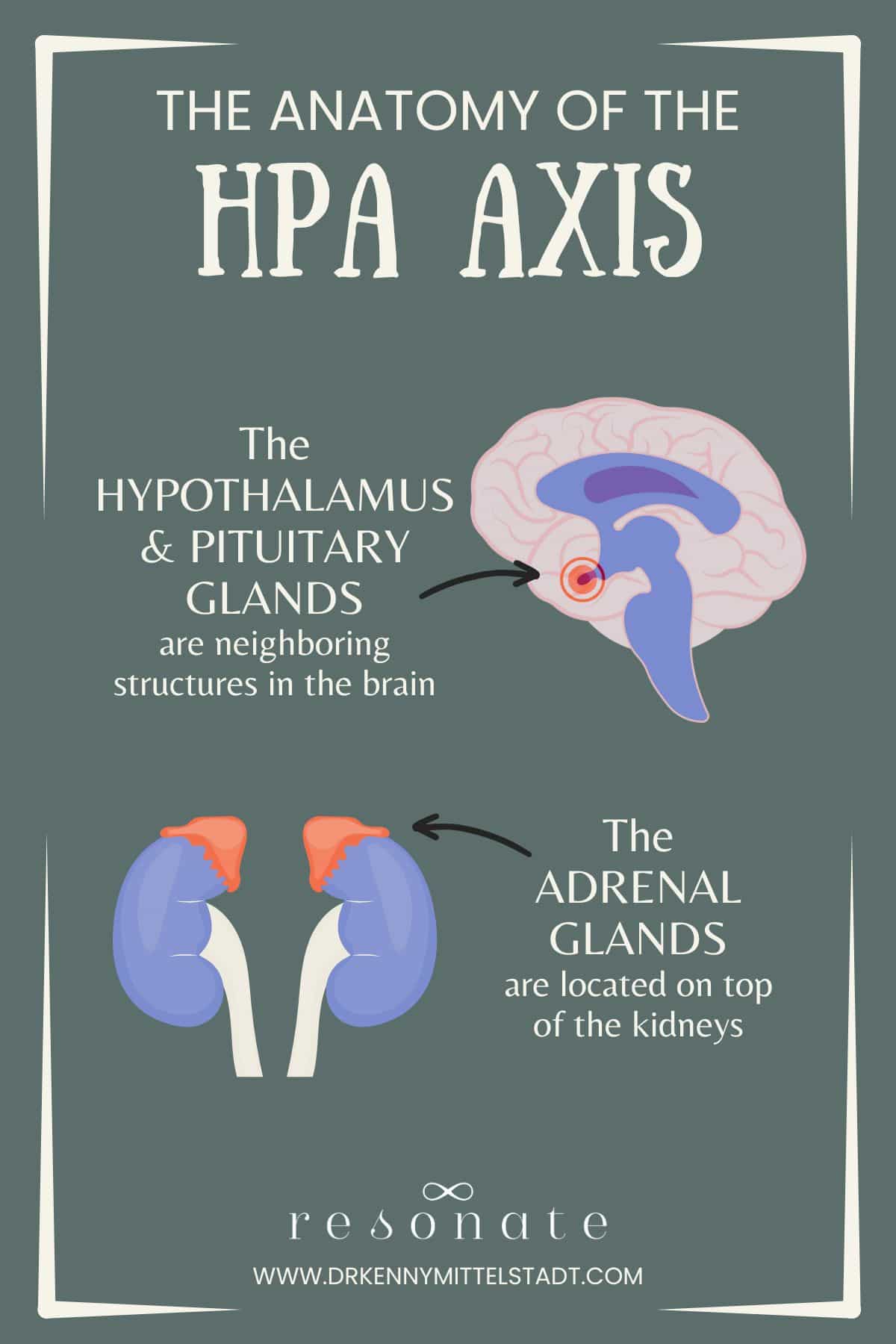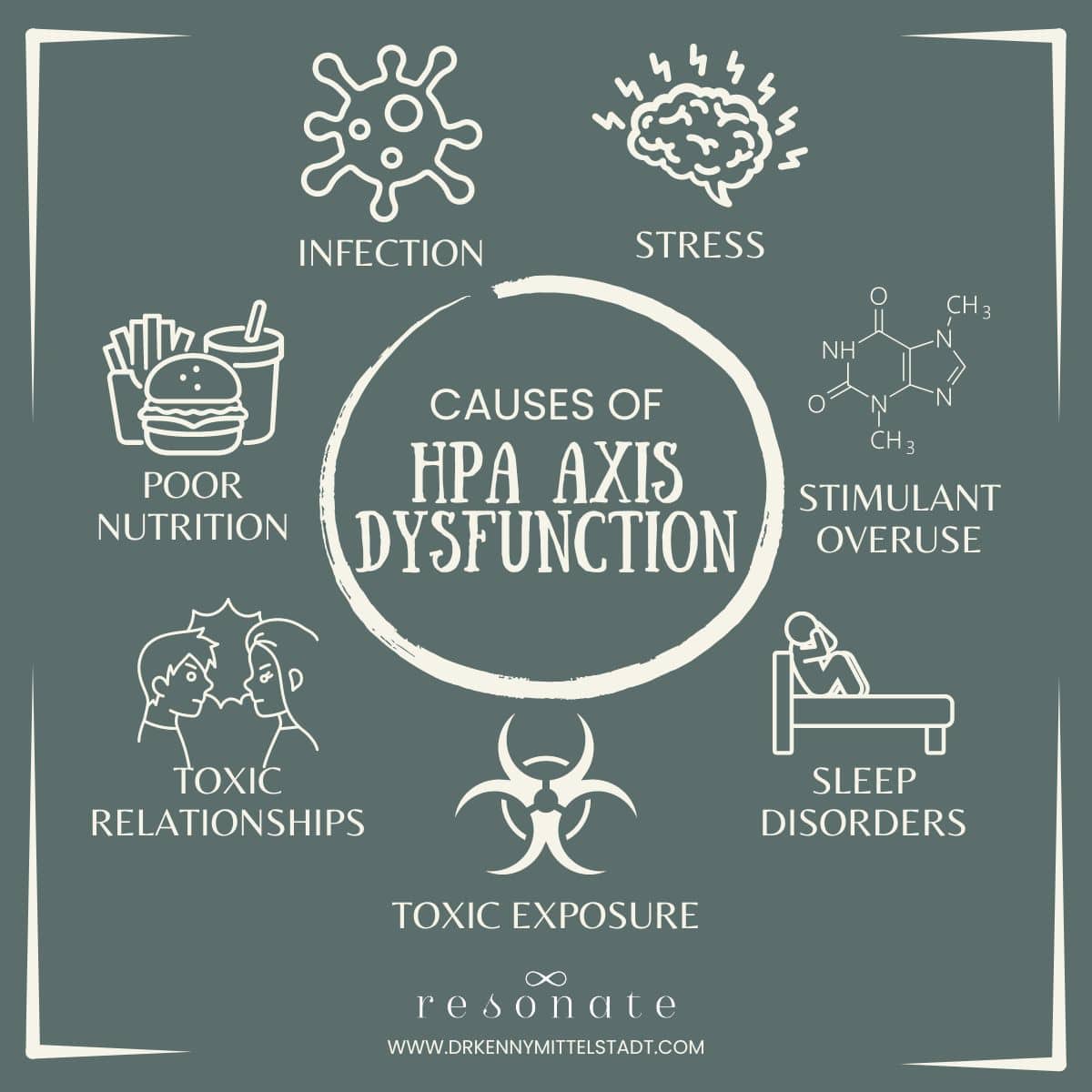Chronic fatigue, low energy, difficulty falling or staying asleep, depression, anxiety, PTSD, low thyroid function, brain fog, being more reactive to stressors, difficulty losing weight – do any combination of these experiences resonate with you? If so, consideration might be given to HPA Axis Dysfunction as the root of these common complaints.
Though it may not be black and white, it could be a contributing factor to why you can’t seem to get over the hump of feeling better, having optimal energy, and rejuvenating sleep.
What is HPA Axis Dysfunction you ask? Zoomed out, you might think of it as an imbalance of our nervous and hormonal systems. These systems govern our everyday activities and our mental, emotional, and physical set points.
“Adrenal fatigue” is an informal, outdated, and inaccurate term that has been used to describe what we more appropriately call HPA Axis dysfunction. Unfortunately, this term is incomplete, less contextual, and can be misleading.
I ask you to consider our fast-paced, overworked, overstimulated, stressed out society. Think about how this affects our set points!
In this post, we’ll come to better understand HPA Axis Dysfunction – its symptoms, causes, and potential diagnostic and intervention options through the lens of functional medicine!
Overcoming HPA Axis dysfunction can be part of your ticket to optimizing health and overcoming wellness roadblocks. Creating balance from within might grant you an easier path toward thriving in life. It’s all about restoring balance, a fundamental concept in functional medicine and Chinese Medicine alike.
Intrigued? Does some of this sound like it relates to your experience? Let’s explore!
What is a “Normal” HPA Axis and how does it relate to Stress?
Stress is a normal human experience. I tell patients all the time that life stressors are a given, but our resilience to stress is something that we can influence. The HPA Axis is a major player in managing such resilience!
The HPA Axis describes a key part of the complex, coordinated system of our nervous system and hormones.

What does HPA Stand For?
HPA is an acronym that stands for the following structures:
- Hypothalamus – Found in the brain, these regulate our response to stress, thirst, hunger, temperature, weight, and other basic life functions such as heart rate, digestion, and circadian rhythms
- Pituitary Gland – Found in the brain, these regulate reproductive function, metabolism, thyroid hormones, and response to stress
- Adrenal Glands – Found on top of the kidneys, these glands regulate stress, blood pressure, produce hormone, and affects fluid and electrolyte balance in the body
And this is not even an exhaustive list of the complex and interconnected functions of this nervous system and hormonal system axis!
Think of this axis as our master control center of our nervous system and hormonal responses to stimuli! It represents the center that controls whether we go into “fight or flight” (sympathetic nervous system response) or “rest and digest” (parasympathetic nervous system response).
All information (stressors, environment, etc.) is processed through the HPA Axis. This control center responds by releasing chemical signals into our bloodstream that reaches virtually every part of our bodies. These chemical signals include our “stress hormones” like cortisol and epinephrine that result in physical and mental-emotional responses.
Can you see how important this system is when it comes to maintaining balance of virtually every process of our bodies?
For example, when we hear a loud noise, our heart rate may rise, body hairs stand up on their ends, and we may sweat and tense our muscles. Then after some time, this stress response dissipates and we continue business as usual.
A well functioning HPA Axis will respond to a stimulus accordingly, and then return to this normal, balanced state.
But what happens when this system becomes overwhelmed or desensitized?
What is HPA Axis Dysfunction?
HPA Axis Dysfunction occurs when this dynamic system becomes uncoordinated, inefficient, or desensitized. This isn’t a black and white situation, and can vary greatly person to person.
Just like many machines and systems, this concept can be looked at as a game of resources. Consider these two scenarios that may underlie HPA Axis Dysfunction:
- A stressor (stressful job, loss of a loved one, a traumatic relationship, etc.) is applied to the HPA Axis to a long time or in incredibly high amounts
- You don’t have the resources to create an appropriate response to match the intensity or duration of the stressor
See how both of these scenarios represent the creation of imbalance or desensitization on the HPA Axis? A person may feel stuck in the “fight or flight” as a result of either one of these destabilizing situations. Read more about Stress and the HPA Axis here.
If we consider prehistoric times, stressors generally came and went – encountering a tiger for example – and then there was time for relative rest and recovery. In our society today, stressors are relatively constant and insidious – corporate America, information and technology overload, violence in film and television for instance.
Do you see how “adrenal fatigue” is an oversimplified and incomplete picture of this complex imbalance? The adrenal glands represent just one player of this complex system. Additionally, the manifestations of this are not reliably attributed to the adrenal glands. This is why using the phrase HPA Axis Dysfunction better describes the situation.
Causes of HPA Axis Dysfunction
There are many ways that imbalance happens in this complex system. In short, think of examples of life situations that might put us in sustained states of “fight or flight” mode.
Causes of HPA Axis Dysfunction include the following:
- Stress at work, home, etc.
- Toxic and other unhealthy relationships
- Infections
- Over exercising
- Not eating enough, nutrient deficiencies
- Alcoholism
- Overuse of caffeine or other stimulants
- Food allergies or sensitivities
- Exposure to environmental toxins
- Trauma and Adverse Childhood Events (ACE’s)
- Hormone imbalances
- Some medications
- Genetic issues (SNP’s)
- Sleep Disorders
- Other or multiple causes

This is the way I sometimes summarize the causes of HPA Axis Dysfunction to patients. In many ways, it’s a byproduct of our current society and human experience.
We demand more and more of our bodies as machines. Think of the information overload we experience, overworking for the sake of “progress”, constant competition for limited resources, exposure to low-grade environmental toxins, poor nutrition – the list goes on!
We might considers what this levell of demand does to our actual nervous system and hormonal set points and what kind of things we can do that support us from the inside out!
Signs & Symptoms of HPA Axis Dysfunction?
Since the glands and hormones that make up the HPA Axis affect virtually all tissues in our bodies, the potential signs and symptoms are many.
A person with potential HPA Axis dysfunction may experience any one or combination of the following complaints:
- Low energy and chronic fatigue
- Insomnia or other sleep disturbance
- Feeling “Tired but Wired”
- Weight gain, weight loss, difficulty losing weight
- Irritable bowel syndrome, constipation, (Stress and IBS)
- Gut health issues, microbiome imbalance (dysbiosis) (Stress and the Gut-Brain Axis)
- Low libido, low sex hormones
- Leaky Gut (AKA Intestinal Permeability)
- Anxiety
- Depression
- Migraines
- Brain fog, difficulty concentrating
- Low thyroid function (hypothyroid states)
- Menstrual cycle complaints including PMS and PMDD
- PCOS (Polycystic Ovary Syndrome and Cortisol Levels)
- Body aches and pains

This is not an exhaustive list, but represents some of the most common related conditions that I see HPA Axis dysfunction with patients in practice. Did you know that our adrenal glands can actually increase in size in response to these increased demands?
How to Test for HPA Axis Dysfunction?
There are several ways to assess the hormonal patterns that give your practitioner insights into the functioning of the HPA Axis. There are tests designed to analyze hormone levels in the blood, saliva, and urine.
A common, go-to functional medicine lab involves looking at one’s production of cortisol and DHEA in the saliva. Normally, salivary production of these hormones follow certain biorhythms. Usually samples are taken at several points throughout the day and compared to “normal” rhythms and patterns we’d expect to see.
The 3 Stages of “Adrenal Fatigue”… rather HPA Axis Dysfunction
Next, we will talk briefly about the 3 Stages of “Adrenal Fatigue” or HPA Axis Dysfunction as they relate to Selya’s General Adaptation Syndrome from 1936. These relate to cortisol and DHEA as suggesting different stages of HPA Axis Dysfunction.
Though there is more variability in the human population, these 3 stages can describe most circumstances. When a person’s HPA Axis is being challenged by chronic stressors, their hormones may progress through the following 3 stages.
Stage 1 – The Arousal or Alarm Stage
In this stage, functional labs usually show transient increased cortisol (a primary stress hormone) and usually increased DHEA. Think of this stage as the beginning of the “overwhelming” process of the HPA Axis. A person may be experiencing regular high stress, but they are generally able to return to a normal balanced state.
Stage 2 – The Resistance or Adaptation Phase
In this stage, functional labs usually show more consistently increased cortisol, and normal or low DHEA. A person in this stage may experience a sense of heightened stress, even in situations where a stressor doesn’t exist. Picture a person who has a “short fuse” or is hyperreactive.
Stage 3 – The Exhaustion Phase
In this stage, functional labs usually have both low cortisol and low DHEA. This is a “deficiency state” and the symptoms usually mirror this. There is not enough stress hormone available or released and a person may feel exhausted or burnt out. This is the stage that was most commonly associated with “adrenal fatigue” but remember, it’s not a formal diagnosis or big picture description.
The Functional Medicine Treatment of HPA Axis
To summarize the functional medicine treatment strategies, the goal is to resensitize or resupply the HPA Axis. What kind of things can you think of that balance the stressors and causes that we looked at earlier?
Consistent with the functional medicine principle of personalized, holistic treatment, one’s pathway to overcoming HPA Axis dysfunction is unique to their needs and individual circumstances.
Functional medicine may use any combination of the following interventions over the course of weeks to months to help restore HPA Axis function:
- Hormone replacement
- Nutraceutical support (Adaptogens, nutrient replacement, etc.)
- Stress reduction and management
- Counseling, CBT
- Yoga, Meditation, Deep Breathing (The Effect of Yoga on Cortisol Levels in Patients with Breast Cancer)
- Nutrition counseling and blood sugar control
- Movement and Exercise Advice
- CAM treatments such as Acupuncture and Brainspotting
- Laughter and Joy
Of course, each treatment is tailored to your individual labs and needs. Consult with your functional medicine practitioner
Conclusion
So there is it! HPA Axis Dysfunction in a nutshell. Hopefully this exploration offered you a better understanding of the big picture of this modern experience.
We discussed why HPA Axis Dysfunction occurs, the many ways that it manifests, and how to test for it and treat it.
Functional medicine treatments may be a great way to restore balance to a dysfunctional nervous system and hormonal system. But the long game is also about creating health and wellness that supports our HPA Axis through lifestyle – all of the things that support our “rest and digest” functions in this “fight or flight” world!
If this topic hits home, reach out about becoming a patient or seek help from a functional medicine practitioner. What is functional medicine? Read Part 1 of this blog series that compares functional medicine to conventional medicine.
Knowledge of our health situations is empowerment. Health is contagious, share the love. Send this post to a friend, follow me on Instagram and subscribe to mailing list below for updates on health programs and all things functional medicine and wellness with Resonate!
About the Author
Kenny Mittelstadt is an acupuncturist and functional health practitioner based in San Antonio, Texas. He is trained through the Institute for Functional Medicine and received both of his doctorate degrees with highest honors from Southern California University of Health Sciences. He focuses on empowering patients through creating opportunities for integrated understanding and personalized root-cause healing - starting with gut health and growing beyond!

